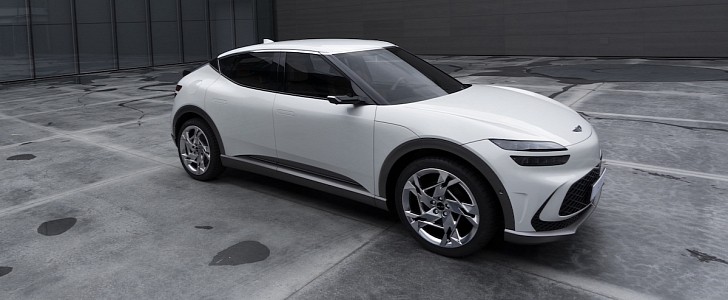When the internal combustion engine vehicles appeared at the beginning of the 19th century, they looked more like horse-drawn carriages, and only later did they evolve to be as we know them today. The same will happen with electric vehicles, which presently still look like ICE cars.
While the ICE cars needed a designated compartment for the engine and transmission, the EVs no longer need that - instead, carmakers can choose the location for the motors. And while the first electric vehicles used the existing engine compartments for motors (like the Golf EV), other carmakers placed the motors under floors or in wheels hubs. Also, the battery packs were stored inside the platform, improving the cabin’s space and lowering the center of gravity.
Genesis didn’t really start from scratch with the GV60 since Hyundai already had some experience with electric cars. But the overall design was a completely different story, and, as a premium brand, it had to create its own visual identity. It still looks like a car with an engine compartment at the front and a coupe-like greenhouse sitting on top of a crossover bodywork. It is a mix between a hatchback, a coupe, and an SUV.
At the front, the LED headlamps represent the signature lights for the Korean brand. The carmaker names them quad-lamps since there are two pairs of horizontal lamps on each side of the front fascia. The minimalist design of the vehicle shows fewer lines and almost no angles on the sides, only curved and flat surfaces. Moreover, due to the lack of the drivetrain assembly, the carmaker could push the wheels to the car’s corners, thus resulting in very short overhangs, both front, and rear.
Genesis designers emphasized the floating roof concept and created a chromed line wrapped around the windshield and ran above the windows line onto the rear with a V-line shape on the C-pillars, in a so-called “Volt-DLO” concept. At the back, Genesis carried over the same quad-lamp design signature from the front. But they will have to figure out a way to comply with the U.S. laws, which require the brake lights to be mounted on unmovable body parts, such as on quarter-panels. An additional red light strip will cross the rear wing, mounted on the lower side of the windscreen, not as a roof spoiler like most other crossover coupes on the market.
Inside, Genesis installed a crystal sphere as a drive selector on the armrest/center console, between the front seats. It lits differently, depending on the car’s status, and shows if the motors are powered or not. The carmaker considers that a small signal on the instrument panel is not enough. Moreover, that crystal sphere is also considered a safety feature since it is impossible to engage the drive mode while a charger cord is still attached.
Genesis didn’t really start from scratch with the GV60 since Hyundai already had some experience with electric cars. But the overall design was a completely different story, and, as a premium brand, it had to create its own visual identity. It still looks like a car with an engine compartment at the front and a coupe-like greenhouse sitting on top of a crossover bodywork. It is a mix between a hatchback, a coupe, and an SUV.
At the front, the LED headlamps represent the signature lights for the Korean brand. The carmaker names them quad-lamps since there are two pairs of horizontal lamps on each side of the front fascia. The minimalist design of the vehicle shows fewer lines and almost no angles on the sides, only curved and flat surfaces. Moreover, due to the lack of the drivetrain assembly, the carmaker could push the wheels to the car’s corners, thus resulting in very short overhangs, both front, and rear.
Genesis designers emphasized the floating roof concept and created a chromed line wrapped around the windshield and ran above the windows line onto the rear with a V-line shape on the C-pillars, in a so-called “Volt-DLO” concept. At the back, Genesis carried over the same quad-lamp design signature from the front. But they will have to figure out a way to comply with the U.S. laws, which require the brake lights to be mounted on unmovable body parts, such as on quarter-panels. An additional red light strip will cross the rear wing, mounted on the lower side of the windscreen, not as a roof spoiler like most other crossover coupes on the market.
Inside, Genesis installed a crystal sphere as a drive selector on the armrest/center console, between the front seats. It lits differently, depending on the car’s status, and shows if the motors are powered or not. The carmaker considers that a small signal on the instrument panel is not enough. Moreover, that crystal sphere is also considered a safety feature since it is impossible to engage the drive mode while a charger cord is still attached.













